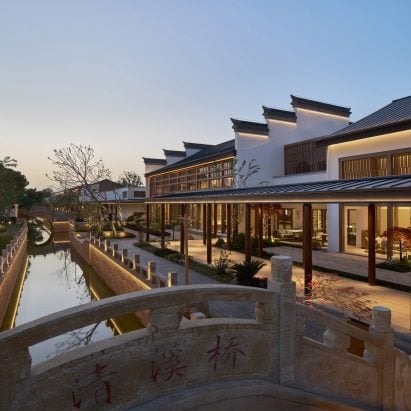Architecture studio WATG and Wimberly Interiors have completed a boutique hotel in Wuxi, China, evoking a sense of tranquility informed by local poetry.
Named Hotel Wuxi MGallery Collection, the hotel is located within Dangkou Ancient Town, a typical Jiangnan-style area featuring canals, arched stone bridges and traditional courtyard houses built almost 2,000 years ago.
The hotel is located within an ancient water town in Wuxi
Both the exterior and interiors of the hotel pay homage to the architectural language of the surrounding site, particularly referencing the former residence of Hua Tai Shi – a historical poet from the region.
The buildings on the hotel compound all adopt traditional north-south orientations, with their forms, rooflines and internal courtyards nodding to Jiangnan’s architectural vernacular.
The exteriors of the hotel blend into the surrounding townscape
The hotel stands next to an ancient canal, which is crossed by arched bridges and sheltered walking passages, typically seen in traditional Jiangnan gardens.
“Hotel Wuxi MGallery Collection offers an immersive experience that connects guests with the cultural legacy and rhythm of the region,” said WATG creative director of architecture Raghavendra Shanbhag.
“We took great care to honour historical heritage and tradition, weave in community-centred elements with public access spaces, and create a contemporary, immersive experience for guests that extends beyond the bounds of conventional hospitality.”
A water courtyard is served as an arrival hall
Upon arrival, guests enter a water courtyard, known as the Moon Court.
The circular opening on top allows collected rainwater flow into the courtyard below, creating a dramatic water screen.
Next, the main lobby features a backdrop of bookshelves overlooking the canal, described as “a contemporary interpretation of Hua’s personal library”.
The wall envelops the bar features locally crafted blue ceramic tiles
A bar within the lobby has a wall clad with locally crafted blue ceramic tiles, with Hua’s poetry scripts carved into it and lighting strips that mimic his brush stroke painting.
The restaurant features tree-informed ceiling design and suspended ceiling installations that create a dining experience under a tree, echoing the name of the space “The Tree Canopy”.
The hotel also contains a teahouse and a cultural hub that showcases Hua’s literary works, with a conserved Huang Shi Nong water feature designed to create a peaceful and meditative setting.
There are four types of guest rooms throughout the hotel, all with garden views, which stays true to Hua’s former residence design.
The ceiling installations inside the restaurant are informed by tree canopy
Natural elements, as described in Hua’s poetry, serve as the foundation of the visual narrative.
The muted colour palette and natural wood materials combined with replicas of Hua’s artwork in each room, was designed to create a mood that encourages guests to pause, reflect, and find inner peace.
“We honour Dangkou Ancient Town’s literary and architectural traditions through interiors that are rooted in local proportions, materials, and sensory richness that invites guests to slow down and engage with their surroundings,” said Wimberly Interiors creative director Paolo De Simone.
All guest rooms include unique garden views
Specializing in hospitality design, WATG was founded in 1945, with offices across US, UK, Singapore, and China. In 2008, it launched its interior design firm, Wimberly Interiors.
Other recent projects completed in China include a creative hub in Dalian, wrapped in a rusty Corten steel facade, and a pavilion on a rocky site in Chongqing with a stepped roof of imitation stone.
The photography is by Seth Powers.
The post Hotel Wuxi MGallery Collection informed by historical poet’s home appeared first on Dezeen.
